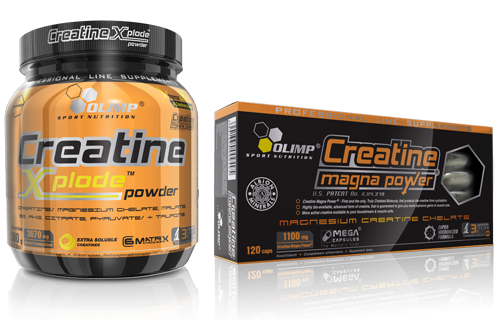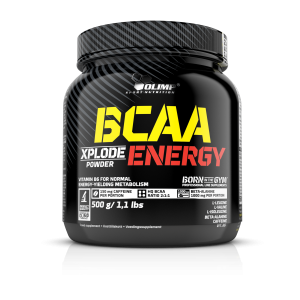Modern forms of creatine

It seems to leave no doubt that creatine is the best known, widely used and thoroughly tested supplement, used by most of the athletes, both professionals and amateurs.
Creatine, or 2-(Methylguanidino) ethanoic acid, is an amino acid which, after phosphorylation in the presence of creatine kinase, is converted into creatine phosphate – the basic energy-storing compound in the body, playing a key role in the regeneration of adenosine triphosphate (ATP) present in muscle cells, which is the main energy carrier in cell and tissue structures (Feldman EB. 1999).
Many review papers (including R. Balsom et al. 1994, Greenhaff R. 1995) have demonstrated the ergogenic action of this compound (it improves exercise capacity, pushing it above the limits achievable through normal training), thus suggesting the validity of its use in sports supplementation. At the same time, it has been observed that due to the high conversion of creatine to creatinine in the acidic environment of the stomach, the loss of this supplement are significant, which makes its use in the sport not very economical.
Following this, work has begun on the creation of creatine molecule more resistant to the process of cyclisation (lactamation), with research heading in two directions. On the one hand, it has been attempted to protect the reactive groups of creatine by linking them with acids or alcohols, while on the other hand alkaline metal compounds have been used in mixtures with creatine. These treatments have proven very effective indeed. Modern forms of creatine have better solubility, are much more resistant to the acidic environment of the stomach, and thus exhibit higher efficacy. A new wave of research on them has already started. In 2008, Jäger and colleagues sought to determine the effects of supplementation with creatine citrate, and pyruvate on the exercise capacity in healthy young athletes doing interval training. After 28 days of supplementation at 5 g daily, an increase in average strength has been noted for both compounds. In the case of citrate, it covered the first 2 intervals, and lost on significance in the later stages of the experiment. In the case of pyruvate, the marked growth in strength encompassed all intervals. Both forms of creatine significantly raised the rate of muscle contraction, but only pyruvate increased the rate of relaxation as well. These differences will become easier to understand in view of studies conducted by Harris and colleagues (2007), which showed how different forms of creatine elevate the level of free compound in the blood. The results of the analysis are shown in the table below.
| |
Creatine Monohydrate |
Creatine Citrate |
Creatine Pyruvate |
| Time (h) |
Mean Concentration |
Mean Concentration |
Mean Concentration |
| 0.0 |
40.5 |
56.5 |
44.0 |
| 0.5 |
488.6 |
551.1 |
637.0 |
| 1.0 |
761.9 |
855.3 |
972.2 |
| 1.5 |
660.8 |
771.8 |
875.7 |
| 2.0 |
557.0 |
624.2 |
681.7 |
Source: Harris, R. et al. Comparison of New Forms of Creatine in Raising Plasma Creatine Levels. J Int Soc. SPTS. Nutr., 2007, 4, 17-22.
Pyruvate proved more effective than citrate and monohydrate because its intake resulted in maintaining a high level of free creatine in the blood for a longer period of time (see table). In view of the above, it may be concluded that similar differences may exist between, for example for example, creatine ethyl ester, malate or α-ketoglutarate, but, because of the chemical structure characteristic for each of the molecules, their properties, and thus absorption kinetics, will be different.
For this reason, the currently designed modern formulations aimed to aid in sports exercise, such as Creatine Xplode™, include in their composition several forms of creatine of advanced molecular structure (malate, ethyl ester, α-ketoglutarate, pyruvate, citrate, or a true “gem” in the group – the excellent creatine magnesium chelate – Creatine Magna Power®). The idea is to raise the level of blood creatine as quickly as possible, by delivering substrates of maximally diversified absorption kinetics, which will allow to maintain very high levels of creatine in body fluids and in tissues over a long period of time. The use of ester or chelated forms of creatine reduces to a minimum their conversion into inactive form. All of this has one purpose – to ensure for a sportsperson a continuous supply of top-quality substrates for energy production, since the demand for it during intense exercise can be as high as 0.5 kg of ATP per minute. In the case of such a complex product as Creatine Xplode ™ it is not necessary to use large doses of creatine, since even with a smaller one their cumulative effect is significantly higher than that induced by a standard dose of a single form of creatine consumed separately.
An innovative achievement in the synthesis of more and more effective forms of creatine is the excellent creatine magnesium chelate (Creatine Magna Power®; Cr-Mg) – a combination of magnesium and creatine in a single, stable molecule. In view of the fact that these two compounds are closely related functionally in the metabolic processes of energy generation and conversion, the researchers from Albion Advanced Nutrition® considered as obvious the necessity to design a single molecule that could deliver both substrates to the abovementioned processes.
The use of reactive chemical groups of creatine to form bonds with magnesium makes the creatine molecule more stable, preventing it from cyclisation and making it more accessible to physiological processes. Alkaline magnesium also reduces the acidity of creatine environment. When reviewing studies in humans conducted in the years 2001-2009 with the aim of determining the efficacy of creatine magnesium chelate (“Mg Creatine Chelate Threads Research, 2001-2009 “, Albion Research Notes, 2009, 18 (3)), it appears that the most significant increase in strength was indeed observed after 4 weeks of supplementation with creatine magnesium chelate. In addition, the group receiving supplementation with this preparation reported lower discomfort due to delayed onset muscle soreness (DOMS). The authors suggest that all the positive effects of Creatine Magna Power ® stem from an increased protein synthesis brought about by Cr-Mg supplementation. A 2004 study by Selsby and colleagues additionally indicates increased workout volume post Cr-Mg supplementation as compared with placebo. It should also be noted that, based on the research commissioned by Albion® Human Nutrition, the effects of supplementation with Cr-Mg, in terms of total endurance in the two tests, are incomparably better than those with co-administration of creatine monohydrate and the amino acid magnesium chelate, or – to an even larger extent – creatine monohydrate and magnesium oxide (detailed results: www.olimp-supplements.com). At the same time, this evidences that the development of complex compounds that, upon breakdown in the body, release active substances acting on a number of “intertwining” metabolic pathways, is the future of sports supplementation.
Piotr Kaczka, PhD Eng
BACK ›

